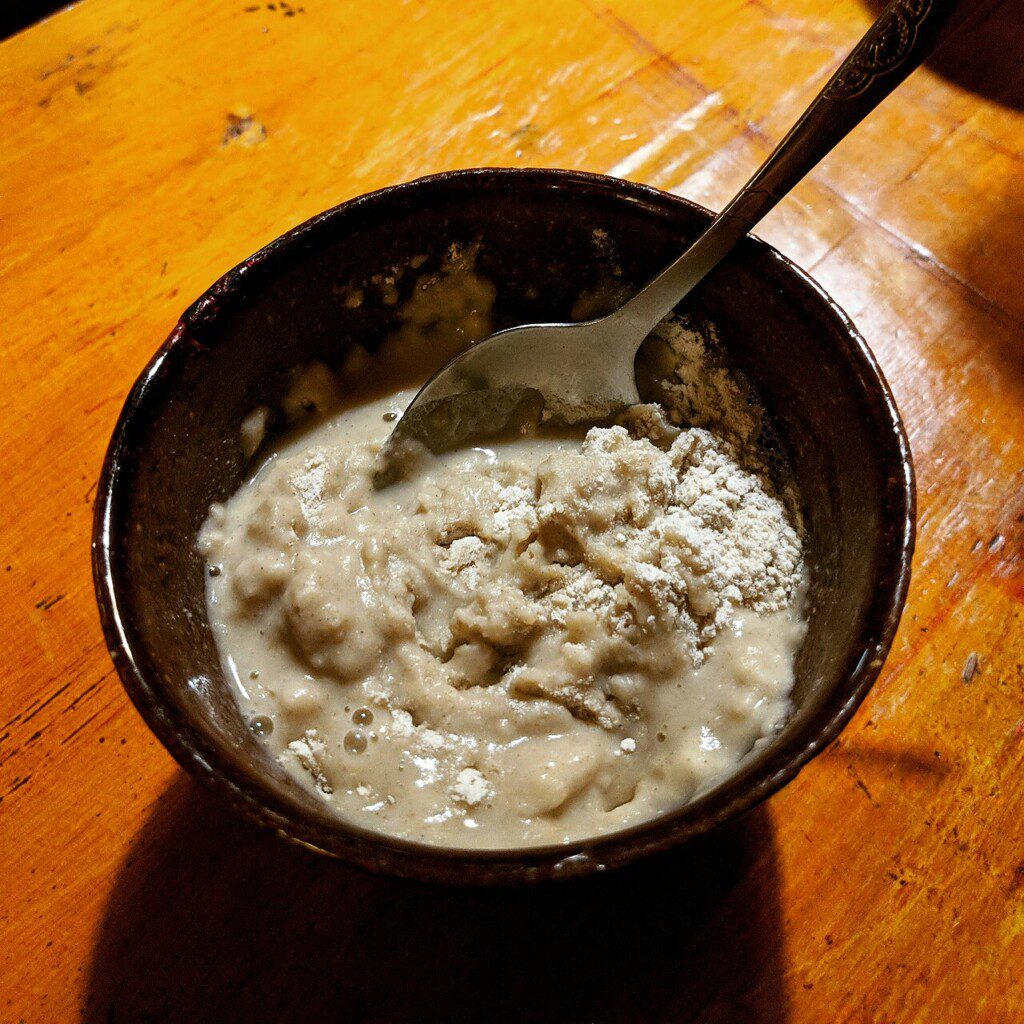Why nutrition matters on a thru hike
- 60-65% carbs
- 15-20% protein
- 15-20% fats

A typical day of eating
Our actual food intake will vary depending on where we are, what’s available in shops or teahouses, and how long we go between resupply points — but we’ve built a typical day around high-energy and portable foods.
Below is what a standard day looks like in terms of food and macronutrient breakdown.
| Meal | Description | Calories | Carbs (g) | Protein (g) | Fat (g) |
|---|---|---|---|---|---|
| Breakfast | 6 Weetabix, Milk powder (rehydrated), Walnuts (handful), Dried strawberries, Decaf coffee | 730 | 90 | 25 | 30 |
| Lunch | 1 cup dehydrated brown rice (rehydrated), 25g freeze dried chicken, banana chips | 700 | 100 | 30 | 20 |
| Dinner | Dal (lentil soup), 1-2 cups white rice, possibly greens or curry when available | 715 | 120 | 25 | 15 |
| Snacks | 1-2 protein bars (Canadian made), handfuls of peanuts or trail mix, chana (dried chickpeas), gummy bears or chocolate | 1,055 | 110 | 30 | 55 |
| Total | All meals + snacks | 3,200 | 420 | 110 | 120 |
This mix keeps our energy levels high, ensures some recovery for muscles, and gives us enough variety to avoid food fatigue.
Food fatigue is real, that’s why we have a mixture of flavours of bars and a range of nuts for snacking. On days of higher effort, we will add olive oil to meals to increase calories.
We’re flexible day to day, but this gives us a solid nutritional baseline we can adjust from depending on access to teahouses, how hard the terrain is, and what we’ve been able to resupply.
What we'll eat along the way
Teahouse Meals
We’ll eat dal bhat and rice whenever we pass or stay in a teahouse or guesthouse. We will also try tsampa and noodle dishes. These options are popular and reliable hot meals. Teahouses can supply breakfasts as well.
While dal bhat in particular is filling and culturally immersive, it’s carb-heavy and light on protein. We haven’t grown up eating it every day, and it wouldn’t meet our nutritional goals — especially not on days when we’re burning through calories at a high rate. For this reason we will also carry protein powder to supplement.
Kristy sees this as important as women in their 40s need to prioritize protein intake to maintain muscle mass and support bone health, as estrogen levels decline and the body’s composition changes.
Shops and Resupply
Along the way, we’ll pass small shops, however in more remote areas these typically only stock instant noodles and biscuits. This means we’ve had to plan carefully to bring the right nutrition from the start for resupplies, and supplement when we can.

Food from Canada vs Nepal
Getting the right food mix requires strategy — and some extra baggage. Here’s how we’ve broken it down…
Bringing from Canada (hard to find / essential)
These are mostly protein-heavy items or snacks we know our bodies tolerate on longer days:
- Tuna in flat packs (people who know me know I love tuna flat packs!)
- Turkey jerky and freeze dried chicken (we tried dehydrated tofu but it’s not quite the same)
- Egg crystals (dehydrated egg, versatile and protein-rich)
- Canadian bars (Hornby and Daryl’s)
- Sesame crisps (pack calorie punch per weight)
- Adult multivitamin (daily for me)
- Magnesium (supports muscle function and sleep)
- Vitamin C (immune support)
- Iron tablets (on occasion)
- B vitamins (turns wee bright yellow, what more do you want?)
These options provide a boost when local options are limited, or risky to consume due to hygiene or water concerns.
Sourcing in Nepal (bulk plus base calories)
Angs Himalayan Adventures have stocked us up on bulkier, locally available items that are high in carbs, fats, and plant-based protein:
- Dehydrated vegetables: brown rice, zucchini, capsicum, broccoli, pumpkin, peas, carrots, tomatoes
- Dehydrated legumes: Chickpeas, black beans
- Staples: milk powder, olive oil, peanut butter
- Snacks: chana (dried/salted), almonds, cashews, walnuts, pumpkin seeds, chocolate, banana chips
- Spices: ground cumin, ginger, curry powder, black pepper, salt
A delicate balance
Thru-hiking is a constant negotiation between carrying the weight and having the right nutrition.
We’re always asking: Is it worth carrying? Will it fuel us properly? Will we actually want to eat it after day 90? A five-month hike pushes your body and mind and you need the right fuel to match that challenge.
Nutrition on the trail doesn’t have to be gourmet, but it needs to be intentional. By prepping carefully now, we’re hoping to walk further, recover faster, and enjoy the journey more!


5 Comments
By Tobes
I’m out after breakfast day 1, decaf??!?
Call for the Medivac, I’m done 🚁 💀
By Alpine Fuzzies
LOL! Mike is so innocent putting that on the internet ahahah! Join me in the teahouse for a chai? 🫖 It’s not unlikely that someone has called a chopper because they don’t like the food or drink 🤦 Thanks Tobes. We love you mate.
By Lol I love it tobes. Book me a seat on the helicopter
Another adventure with good preparation
By Bob Gregorish
Sounds like a good plan. I liked your comment about not wanting to eat 2 minute noodles and peanut butter for 5 months. That would get boring pretty fast. You have a good balance of local versus Canadian supplies too. Enjoy! Let me know if you come across some good local recipes.
By Alpine Fuzzies
You might like the Sherpa Stew. It’s delicious but not set recipe. The hand rolled noodles are super delicious and it’s not too spicy or overwhelming. We are having the veggie version but dried yak meat may be interesting to come by in Canmore 😂